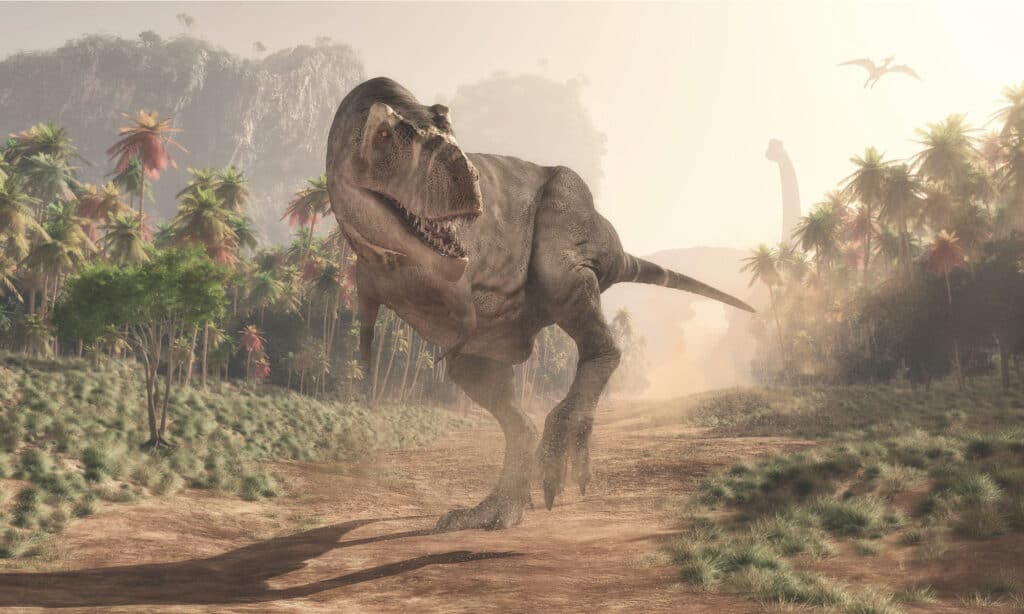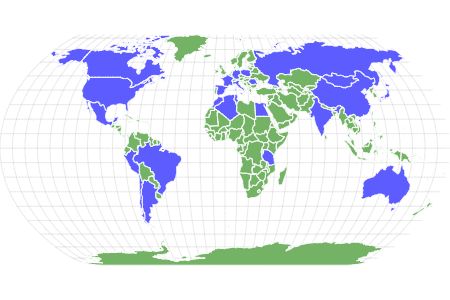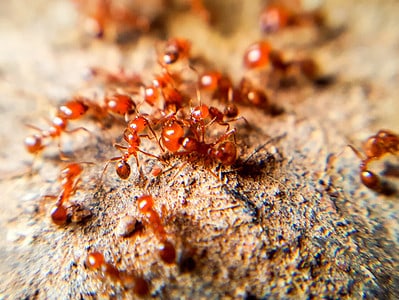Theropod
Theropoda
Some theropods had feathers and may have been ancestors of modern birds.
Advertisement
Theropod Scientific Classification
- Kingdom
- Animalia
- Phylum
- Chordata
- Class
- Amniota
- Order
- Dinosauria
- Family
- Saurischia
- Genus
- Esaurischia
- Scientific Name
- Theropoda
Read our Complete Guide to Classification of Animals.
Theropod Conservation Status
Theropod Facts
- Fun Fact
- Some theropods had feathers and may have been ancestors of modern birds.
- Biggest Threat
- Environmental change
- Most Distinctive Feature
- Powerful bird-like hind legs
Theropod Physical Characteristics
- Skin Type
- Scales
- Aggression
- High
View all of the Theropod images!
Interesting Fact
“Some theropods had feathers and may have been ancestors of modern birds.”
Theropod Facts
- Theropods were a successful and widespread species. Their fossil remains are found on every continent.
- Many theropods had bird-like features, including feathers. These may have been used for insulation, courtship displays, or for some species possibly even flight.
- The theropods had long, powerful hind limbs, which they used for running and hunting. These were often much longer and more heavily muscled than their forelimbs.
- Many theropods had highly specialized teeth, adapted for slicing through flesh or crushing bones.
- Some theropods had decorative features, such as crests, horns, or frills, which may have been used for courtship displays or as a means of defense against predators.
Theropod Scientific Name
The theropods are a group of dinosaurs within the suborder Theropoda, which belongs to the order Saurischia. The word “theropod” comes from the Greek words “therios,” meaning “wild beast,” and “podos,” meaning “foot.” This refers to the fact that the theropods were carnivorous dinosaurs with bird-like feet.
Probably the most famous theropod is the tyrannosaurus rex, or t-rex. “Tyrannosaurus” is Greek for “tyrant lizard,” and “rex” means “king” in Latin. Thus, Tyrannosaurus rex was “King of the Tyrant Lizards.”
Description & Size

Tyrannosaurus Rex in the jungle. Commonly known theropod.
©Orla/Shutterstock.com
Theropod Size
The theropods were a wide range of dinosaurs that were bipedal–walking upright on two long, powerful hind limbs that enabled them to run quickly to catch prey. Their forelimbs were much shorter and less muscular. Theropods ranged widely in size, from smaller, feathered species like coelurosaurs and velociraptors to large, apex predators like the allosaurids and tyrannosaurids, including the famous tyrannosaurus rex. In length, these dinosaurs ranged from two feet to over fifty feet. Here are some examples of the size ranges for some well-known theropod species:
- Velociraptor: 6-9 feet long, 2-3 feet tall, weighing up to 50-100 pounds
- Utahraptor: 20-25 feet long, 6-8 feet tall, weighing up to 1 ton
- Allosaurus: 30-40 feet long, 12-15 feet tall, weighing up to 2-3 tons
- Tyrannosaurus rex: 40-50 feet long, 15-20 feet tall, weighing up to 7-8 tons
Theropods could run relatively quickly, an adaptation that helped them both in hunting and in evading larger predators. Based on studies of the anatomy and biomechanics of the theropods and other dinosaurs, paleontologists have made some estimates of the running speeds of some theropod species. Here are some examples:
- Velociraptor: 20-30 mph
- Utahraptor: 25-35 mph
- Allosaurus: 15-25 mph
- Tyrannosaurus rex: 20-30 mph
Theropod Descriptions
Theropods had a number of bird-like features, including 3-toed feet ending in sharp claws and in some cases feathers, which have been discovered as impressions in some theropod fossils. Their feathers may have been used for insulation, courtship displays, or even flying. These features lead researchers to believe theropods were ancestors of modern birds.
Some theropods had decorative features, such as crests, horns, or frills, which may have been used for courtship displays or as a means of defense against predators. These features varied greatly in size and shape depending on the species.
Theropod teeth possess specialization for different kinds of prey. Some had long, sharp, blade-like teeth suitable for slicing through flesh while others had thicker, blunter teeth for crushing the heavy armor and bones of their prey.
Theropod Evolution and History
Theoropods lived during the Mesozoic Era, which lasted from about 252 to 66 million years ago. They first appeared in the Late Triassic Period, around 230 million years ago, and persisted until the end of the Cretaceous Period, around 66 million years ago, when they and most other dinosaur species went extinct.
During this time, the theropods evolved into a wide range of species, including small, feathered coelurosaurs, large, predatory allosaurids and tyrannosaurids, and many others. The theropods were an important part of the Mesozoic ecosystems, and played a variety of roles, from apex predators to scavengers to herbivores.
They are believed to be the ancestors of modern birds, and many theropod species had feathers or other bird-like features. The evolution of feathers and flight in the theropods played a key role in the success of this group, and helped them to adapt to a wide range of environments and ecological niches.
Diet – What Did Theropods Eat?
The diet of theropods varied depending on the specific species. Many theropods were carnivorous, meaning that they primarily ate other animals, while others were omnivorous, meaning that they ate a mix of plants and animals. Some theropods, such as the spinosaurids, may have been piscivorous, meaning that they primarily ate fish.
There is evidence that some theropods, such as the tyrannosaurids and allosaurids, were apex predators, meaning that they sat at the top of the food chain and had no natural predators. These species would have relied on other animals for their food source, and likely ate a wide range of prey, including other dinosaurs and mammals.
Other theropods, such as the coelurosaurs and maniraptorans, were smaller and may have eaten a more specialized diet. Some of these species fossils have long, blade-like teeth and may have adaptations for slicing through flesh, while others had shorter, blunter teeth for adaptations for crushing bones or hard-shelled prey.
Habitat – When and Where Theropods lived
They lived during the Mesozoic Era, which lasted from about 252 to 66 million years ago. They first appeared in the Late Triassic Period, around 230 million years ago, and persisted until the end of the Cretaceous Period, around 66 million years ago.
Fossil remains are on every continent. This suggests that the theropods have a wide distribution during the Mesozoic era and in a variety of different environments, from tropical rainforests to arid deserts.
Some of the specific habitats that the theropods may have lived in include:
- Forests: They may have lived in forests, where they could find a variety of prey and shelter from predators.
- Deserts: The theropods may have also lived in deserts, where they could find food and water in the sparse vegetation. Some theropods, such as the ornithomimids, have long, slender legs for running and foraging in desert environments.
- Swamps and wetlands: The theropods may have also lived in swamps and wetlands, where they could find a variety of prey, such as fish and other aquatic animals. Some theropods, such as the spinosaurids, may have been piscivorous, meaning that they primarily ate fish.
They were a widespread and adaptable group of dinosaurs, and they likely lived in a variety of different habitats throughout the Mesozoic Era.
Threats And Predators
It is likely that many of this species were themselves predators, hunting other animals as their prey. Smaller species as well as injured or younger individuals of larger species were likely easy prey.
Some of the animals that may have hunted them as their prey include larger theropods, such as the allosaurids and tyrannosaurids, which were aggressive and predatory. They may also have been preyed upon by pterosaurs–flying reptiles–and crocodilians.
The greatest long-term threat to them was similar to that of other dinosaurs. Climate change and loss of habitat due to long-term processes and catastrophic disasters such as volcanic eruptions and asteroid strikes.
Discoveries and Fossils – Where Theropods were Found
Today, we know about theropods from a wide range of fossil remains. Finds include bones, teeth, eggs, and sometimes even impressions of feathers. These remains have helped paleontologists to understand the evolution and history of the theropods. It has established their place in the Mesozoic ecosystems.
The discovery of the first known fossils began in the late 19th century. Since then, many more fossil discoveries appear around the world. Fossil locations are on every continent, including North America, South America, Europe, Asia, and Africa.
Fossils are on display in many museums and other institutions around the world. Some of the museums that have theropod fossils on display include:
- American Museum of Natural History (New York City, United States): This museum has a large collection of these fossils. Collection including those of the tyrannosaurus rex, the allosaurus, and the velociraptor.
- Natural History Museum (London, United Kingdom): Among the many species on display at this museum are those of the spinosaurus and the carcharodontosaurus.
- Field Museum (Chicago, United States): The outstanding collection of this museum includes those of the deinonychus and the oviraptor.
- National Museum of Natural History (Paris, France): The megalosaurus and the spinosaurus are among the fossils housed at this museum.
- Beijing Museum of Natural History (Beijing, China): The tarbosaurus and the sinraptor as well as many other theropods are available for viewing at this institution.
New discoveries appear regularly as paleontologists continue to search for and study these ancient creatures.
Extinction – When Did the Theropods Die Out?
The theropods, along with many other groups of dinosaurs, went extinct at the end of the Cretaceous Period, around 66 million years ago, in an event known as the K-T extinction. The exact cause of the K-T extinction is still the subject of debate among scientists. The cause is thought to have been by a combination of factors. These include a massive asteroid impact, volcanic activity, and changes in sea level and climate.
It is likely that the K-T extinction event had a major impact on theropod populations and habitats. The event causing them to decline and eventually go extinct. It is also possible that the theropods were already facing challenges and pressures from other factors. These factors include competition from other species or changing environmental conditions, which may have made them more vulnerable to the effects of the K-T extinction event.
Similar Animals to the Theropods
- Coelurosaurs characteristics are their small size, feathers, and long, slender legs. They were highly adaptable and diverse.
- Maniraptorans characteristics are their small size, feathers, and grasping hands. They were highly adaptable and diverse, and included species such as the deinonychus and the oviraptor.
- Ceratopsians: Ceratopsians are a group of herbivorous dinosaurs with characteristics including their large size, horns, and frills.
Related Animals
View all 133 animals that start with TTheropod FAQs (Frequently Asked Questions)
Were theropods carnivores, herbivores, or omnivores?
The theropods were a diverse group of dinosaurs, and their diet varied depending on the specific species. Many theropods were carnivorous, meaning that they primarily ate other animals, while others were omnivorous, meaning that they ate a mix of plants and animals. Some theropods, such as the spinosaurids, may have been piscivorous, meaning that they primarily ate fish.
When were theropods alive?
The theropods were a group of dinosaurs that lived during the Mesozoic Era, which lasted from about 252 to 66 million years ago. The theropods first appeared in the Late Triassic Period, around 230 million years ago, and persisted until the end of the Cretaceous Period, around 66 million years ago.
How big were theropods?
Some theropods were just a couple of feet long while others were large, reaching lengths of up to 50 feet or more.
Thank you for reading! Have some feedback for us? Contact the AZ Animals editorial team.
Sources
- Smithsonian Institution, Available here: https://www.si.edu/newsdesk/factsheets/tyrannosaurus-rex
- Wikipedia, Available here: https://en.wikipedia.org/wiki/Theropoda
- Berkeley.edu, Available here: https://ucmp.berkeley.edu/diapsids/saurischia/theropoda.html
- Britannica.com, Available here: https://www.britannica.com/animal/theropod
- Natural History Museum, Available here: https://www.nhm.ac.uk/discover/dino-directory/body-shape/large-theropod/gallery.html

















